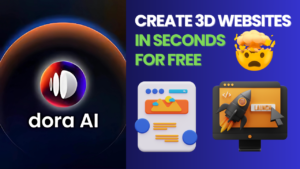1.Google AI Studio
What is Google AI Studio:
3 AI Tools to Make You Smarter & Faster Google AI Studio, which is a browser-based development environment designed to simplify the process of creating, refining, and deploying AI models using Google’s sophisticated language models including Gemini 1.5 Pro. It has a no-code to low-code interface where you can test and interact with generative AI models, share prompts, and utilize APIs in a simple layout free from the pain of learning about machine learning platforms, making development and testing faster and easier.
Key Features of Google AI Studio:
1. Get Access to Cutting-Edge Models
3 AI Tools to Make You Smarter & Faster Google AI Studio provides direct access to cutting-edge large language model (LLM) technology, including Gemini 1.5 Pro so you can leverage AI models to build applications that can understand, generate, and reason with human-like text.
2. Prompt Management
Manage and optimize prompts and their associated responses with a simple user interface. Save, organize, and experiment with your prompts in real-time to improve outputs and maximize productivity.
3. Easy API Integration
Google AI Studio allows you to generate an API key and use an associated API and code snippet in Python or Node.js for every prompt you create so you can immediately utilize AI in your applications without needing to think about the backend in your code.
4. Collaboration & Sharing
If you want to share a prompt with your team or the greater community, simply share the link! It is easy to ensure that everyone has access to essentially the same information for collaboration and prototyping.
5. Cloud Storage Connection
Google AI Studio easily connects with Google Cloud Storage and other cloud storage options to provide a seamless connection to the storage for files and cloud services to utilize for AI-style applications inside a scalable workflow.
Advantages of Utilizing Google AI Studio:
- Convenience : Minimal configuration, user-friendly interface, no local implementation.
- Scalability : Backed by Google’s cloud platform delivering performance and reliability.
- Cost-Effective : Generous free tier for developers, and very inexpensive pricing options.
- Safety : Security and privacy delivered at an enterprise-level.
- Customization : Adjust your interactions and outputs via extensible settings.
- Speed : Quick testing and deployment from prototype to production.
How to Use Make AI Effectively(Step-by-Step Guide):
Step 1: Log-in with your Google Account
Go to Google AI Studio and log-in with your Google account. No complex onboarding procedures to navigate simply access the development environment immediately.
Step 2: Start a New Project
Click on the “+ New Prompt” button and start creating a new interaction. You can also copy or edit existing templates to save yourself some time.
Step 3: Select a Model
Select a model (for example, Gemini 1.5 Pro) using the available model selection features in the top toolbar. You can also switch between different models to assess output quality across different models.
Step 4: Compose and Run Prompts
Simply type your prompt in the main editor. Google AI Studio provides syntax highlighting, auto-suggestions, and contextual examples to assist with content entry. Clicking on the “Run” button will provide answers.
Step 5: Change Temperature & Top-P values
Change the model response temperature (0.2 for precision, 0.8+ for creativity) and Top-P to modify the creativity and randomness of the models responses. This is incredibly important for tuning your application’s behaviour.
Step 6: Assess Responses
Review the output from the model in the response panel which is on the right-hand side of the page. If you’re unhappy with the result, you can continue to tweak either your prompt or the model settings and re-run until you achieve the best outcome.
Step 7: Save and Organize Prompts
Use folders and tags to organize all your prompts for efficient access and collaboration with your team
Step 8: Generate API Code
Tap the “Get Code” button to auto-generate snippets in Python or Node.js, along with your unique API key. Copy this to your application to quickly and easily integrate AI functionality.
Step 9: Deploy to Production
When you are satisfied with the behaviour of the prompt, you can deploy your project to production using Google Cloud services or integrate it into existing workflows in your applications through an API.
Step 10: Monitor and Optimise
Utilise Google Cloud’s monitoring capabilities to observe API usage metrics, performance analytics, and any error logs generated. You should also adapt your prompt over time based on user feedback and performance metrics.
Don’t forget to subscribe for easy-to-follow guides and tips.
2.Google NotebookLM
What is Google NotebookLM:
NotebookLM is an AI textbook-type language model that redefines how users interact with information. It is an improved version of normal note-taking apps, for it ingests and understands uploaded documents. This unique feature allows users to ask very advanced questions and receive the responses based on specific provided content.
Key Features of GoogleNotebookLM:
Collective and Organization
- Notebooks: Have separate notebooks for different projects, topics, or categories.
- Sections: Divide notebooks into sections to further organize your content.
- Notes: Write and store individual notes within sections.
Content Creation and Editing
- Text Editing: Edit text with exponential options ranging over bold, italics, and underlining.
- Image and File Upload: Add images, PDFs, and other files to your books.
- Linking: Create links in your notes to other notes, websites, or external resources.
Collaboration and Sharing
- Real-time Collaboration: Invite others to edit your notebooks and sections with real-time support.
- Links, Share: Share notebooks and sections via a link or email.
- Permissions: Control level access for your collaborators; each access can be in terms of editing, commenting, or viewing.
Search and Navigation
- Search: Using the find tool, easily find particular notes, sections, or notebooks.
- Tags: Put tags for notes and sections in order to categorize and filter content.
- Breadcrumbs: Navigate through notebooks and sections using the breadcrumb trail.
Other Features
- Revision History : Getting to know what changes have been made to notes and sections.
- Comments : Features to comment on notes and sections can base the starting point for discussion and feedback.
- Export : Export notebooks or sections into Google Docs, PDF, or text form paper.
- AI-Powered Summaries : Provides short summaries of long documents in no time.
- Contextual Understanding : Provides answers based on your uploaded content.
- Cited for Transparency : With clear citations for factual accuracy.
- Multi-Format : Works with Google Docs, PDFs, and even YouTube transcripts.
- Creation of Content : On its own, creates timelines, study guides, and outlines with notes.
- Audio Overview : It provides a voice-over of key concepts.
How To Use NotebookLM Effectively:
1. Clean your sources well before uploading.
Make sure the sources you are uploading are neatly organized. Use nice file names and tags for easy references.
2. Use more specific prompts.
Instead of: ❌ “Tell me about this document.”
Try: ✅ “Describe the three key arguments presented in this research paper.”
3. Verify information with references.
NotebookLM shows you the source reference behind its answers. Furthermore, for any important information, double-check the accuracy.
4. Create customized study guides.
Students could produce personalized notes, to study through the vast amounts of information presented at any one time more seamlessly.
5. Help Feed Content Creation.
For bloggers, YouTubers, and educators, NotebookLM may be able to:
- Summarize research papers for the main points.
- Generate outlines for blog posts or videos.
- Summarize interviews and discussions.
6. Fast Learning with Audio Overviews.
Conversion of written summaries into audio for on-the-go learning.
3.Emily AI
What is Emily AI:
Emily AI is a virtual AI assistant designed to help with email, meeting scheduling, follow-ups, client communication and to automate processes administratively. It is created to become an embedded aspect of your workflow, acting as a proactive assistant to save time for both professionals and organizations with improvements to productivity, and profitability.
Emily AI mimics human-like conversations and decisions frames while leveraging advanced natural language processing (NLP), machine learning and contextual awareness so that it can deliver timely, and accurate assistance without the need to micromanage.
Key features of Emily AI:
1. Intelligent Scheduling and Calendar:
Emily AI can manage your meetings automatically using your calendar. It connects to your calendar and knows when you are available and can even coordinate other people’s schedules to find an optimal time for you to meet
Notable features:
- Calendar Syncing (Google Calendar, Outlook, etc.)
- Auto-Scheduling Meetings using your preferences
- Smart time zone management
- Sends pre-drafted, individualized confirmations and reminders
2. Email Management and Follow-ups
Emily AI reads, interprets, and replies to emails in a professional but contextual manner acting as your virtual Executive Assistant.
Key advantages:
- AI-generated responses that sound human and polished
- Automatically detects action items within emails
- Automatically follows-up on unanswered messages
- Custom signature and email formatting options
3. Automated Integration With Tools You Already Use
Emily AI works seamlessly with tools like:
- Google Workspace
- Microsoft Office Suite
- Slack
- Zoom
- CRM tools (like Salesforce, HubSpot)
4. Natural Language Understanding and Personalization
Emily AI operates by using deep learning models to understand user requests as well as conversational subtleties. It understands tone, context, and preference, creating a highly personalized experience with your clients or coworkers.
At it’s core are the capabilities of:
- Learning your communication style and tone preferences.
- Adapting to specific language expressions across different domains.
- Multilingual capabilities.
5. Automation and Workflow Process
What is also compelling is the ability to train your Emily AI to take over repetitive tasks such as:
- Organizing travel.
- Help ordering office supplies.
- Sending team updates.
- Preparing meeting agenda and meeting minutes.
6. Security and Data Privacy:
With enterprise-grade security, Emily AI guarantees that all your conversations and data will remain encrypted and compliant with standards such as GDPR and SOC 2.
Security features:
- Role-based access
- End-to-end encryption
- Activity logs and audit trails
- AI data governance policies
How to Use Make AI Effectively(Step-by-Step Guide):
Step 1: Register and Set Up Your Account
Visit the official Emily AI website and sign up for an account (either free or premium depending on need). During onboarding:
- Select your main focus (email assistant, calendar manager, etc.)
- Connect your email, calendars, and task managers
- Select the types of notifications you want.
Step 2: Teach Emily your style of communication
Emily AI is an assistant that is personalized. Provide Emily with examples of:
- Your email replies
- How you like meetings scheduled
- Your keywords for sorting and tagging emails
This will make Emily learn the context better over time.
Step 3: Configure with daily tools
To maximize performance:
- Connect Emily in your CRM, Slack, Zoom, and your project management tools (Trello, Asana, etc.)
- Authorize API access for greater integration and analytics.
Step 4: Begin delegating tasks
You can use simple commands like:
- “Emily, schedule a meeting with John next week.”
- “Reply to this email with a thank you note, and confirm the meeting.”
- “Summarize this document and send it to my team.”
Step 5: Review and Refine
While Emily AI is accurate, reviewing its actions in the first few days ensures it is aligned with what you had in mind.
- Review drafts before auto-sending
- Adjust the tone and formality of the responses
- Use analytics dashboards to monitor performance indicators
Step 6: Make Use of Advanced Features
Increase capabilities with premium features:
- AI-generated reports
- Automated client follow-up
- Meeting transcription and highlights
- Sentiment analysis of emails
Conclusion:
Emily AI, Google AI Studio, Google NotebookLM are the three best ai tools for content creators, students, business people etc.., they provide many crucial features that a person needs, they also provide security to your data. And every single toolhas it’s own feature that makes it very special comparing with the other tools, for example By scaling AI’s efficiency through helpful insights extraction, NotebookLM makes research less daunting and less remote. The user-friendly platform, powerful models, and robust integration with Google Cloud help to make this a special offering for developers and organizations. From the solo entrepreneur to the large organization, incorporating if you include these ai tools into your ecosystem it will be a great way to think about productive, precise, and progressive routines.










